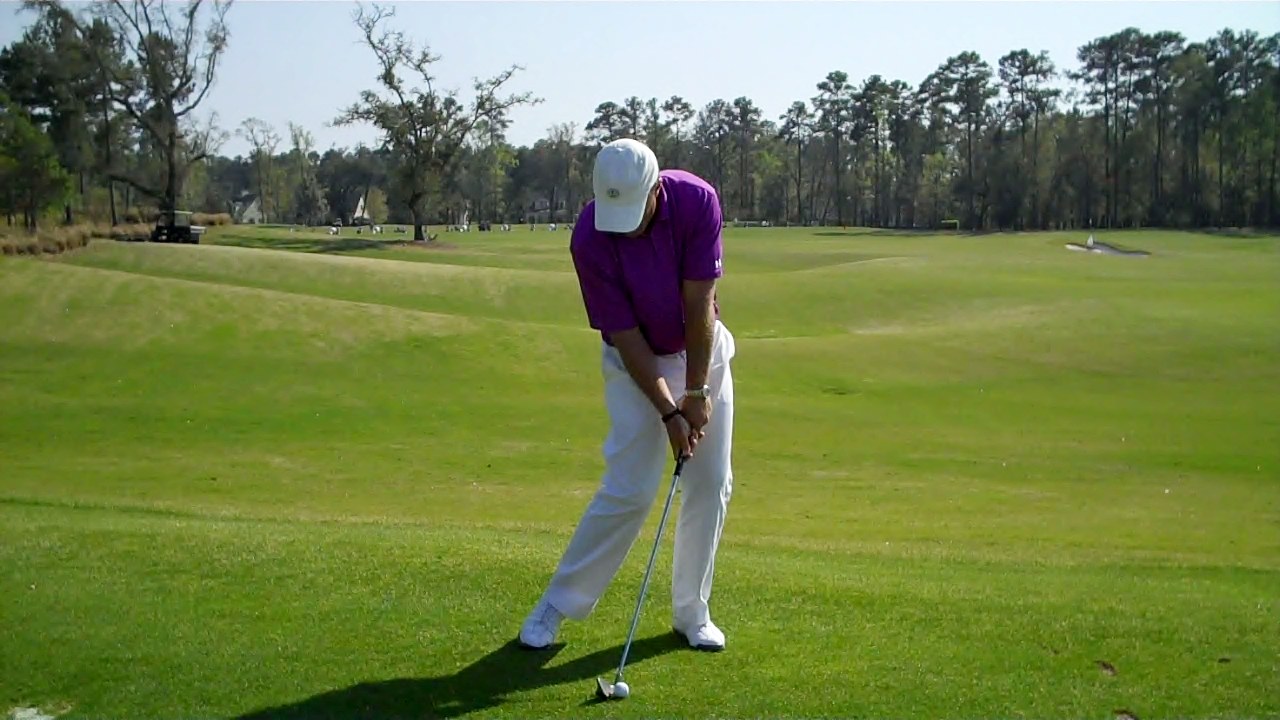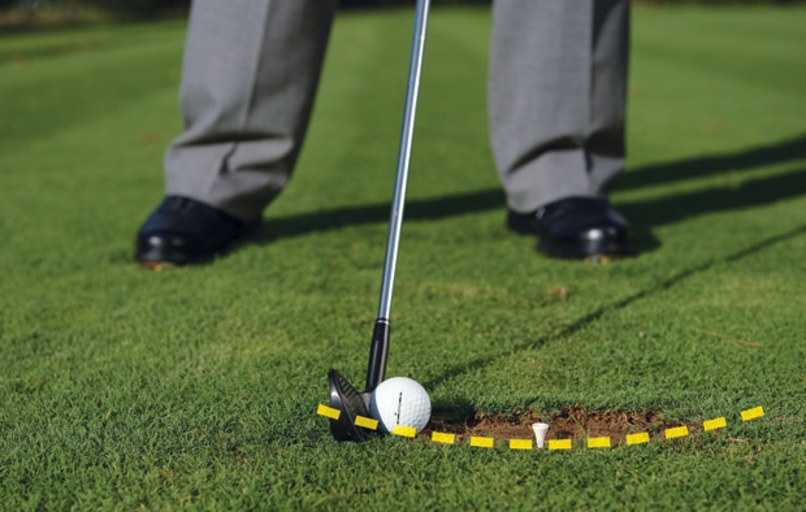At the end of the back swing movement the shoulders/ arms unit have been rotated to the maximum causing the whole body to be formed into a fully twisted condition,.
Therefore to start your downswing, let your weight shift to your
left foot and simultaneously rotate the hips towards the target area for a milli-second before dropping the arms.
The hips must continue to rotate towards the target area, until the end of the golf swing sequence.
This is the first movement in performing the "Magic Move"
See video by Chris Ryan which fully explains the Movement.
As soon as the right elbow gets close to the waist, the right arm must remain in close proximity to the waist, and from that point onwards the whole body ( The Upper Body and the Lower Body) whilst held as a solid one piece unit, is forced to rotate around the axis of the spine, but with the right shoulder controlling the strike of the ball whilst flaying the club head into the back of the ball.
The magic move causes the upper body unit to adopt the impact position, and then as the club head makes contact with the ball the right arm is forced into the straight position whilst the whole body is simultaneously turning to fully face the target area. (whilst the weight of the body is directly over the straight left leg.)
It is absolutely vital that you maintain the focus on the ball --- and subsequently continue to focus on the spot that the ball was resting prior to being struck --- until after the ball has been struck.
Basically what you are doing is using the magic move to cause the hips to rotate/pivot whilst dropping the arms and thus adopting the impact position.
As soon as the lower part of the body has adopted the impact position, the upper body continues to rotate around the central core of the spine, causing the right elbow to move away from the waist line.
The compact upper body unit must not be allowed to become unstable by allowing the arms to drift apart.
At the point of impact the right arm is forced into the fully straightened position.
Whilst the interaction of the arms takes place, you must also ensure that at the precise moment the club head strikes the ball the left wrist if forced into a cupped position thus allowing the wrists to roll as the club head goes through the contact area.
It is absolutely vital that you concentrate on ensuring that you head does not move ahead of the original address position until well after the ball has been struck otherwise you will cause the ball to slice to the right, so give some consideration to purchasing a device I developed to encourage golfers to keep the head in to original address position until well after the ball has been struck.
The raw power is generated by using the rotation of the hips and the upper body unit to forced the right shoulder to rotate under the chin rotate and finally performing the key movement.
Therefore the faster you can rotate the whole body during the critical part of the down swing as the club head swings through the contact area, whilst delaying the release of the club head, the further the ball will go.
( My eyes have been focused on the top/back of the ball from the moment I begun the back swing movement and I have been totally aware of my head position so that it does not sway towards the target area, so during the downswing I am very aware that I must continue to keep my focus sharp)
The elbows are held as close together as it is possible until well after the ball has been struck.
At the precise moment the club head strikes the ball the hands are slightly ahead of the ball, thus allowing the golfer to strike the ball with a downwards manner thus fully compressing the ball. See still Photos of impact position performed by professional golfers.
However at the precise moment the club head strikes the ball, the left arm pulls the club head through the contact area, whilst at the same time the right arm is being fully straightened, thus achieving the interaction of the arms.
( It feels as if the whole movement of the hips and the shoulders stop for a millisecond whilst the interaction of the arms is performed.)
When you have practiced the correct way to strike the ball as detailed in this lesson sufficiently enough to achieve muscle memory, you can begin to concentrate on gradually delaying the release of the club head until the last moment.
It is absolutely vital that at the precise moment the club head strikes the ball, the whole body, especially the hips, must turn to fully face the target area at the same speed the club head is moving towards the target area, without the head rotating away from the frontal facing position.
We are only talking about keeping the head in the frontal facing position for a few milli-seconds after the ball has been struck, but those milli- seconds will determine whether the ball goes where you are aiming, or whether the ball slices off to your right.
Simultaneously the interaction of the arm takes place.
This interaction of the arms is created by fully straightening the right arm as the club head swings through the contact area.
However whilst the interaction of the arms takes place, you must also ensure that at the precise moment the club head strikes the ball the left wrist if forced into a cupped position thus allowing the wrists to roll as the club head goes past the contact area.
As the interaction of the arms takes place the whole body continues to rotate into the follow through movement but importantly, the upper body remains held firmly together as a compact one piece unit.
It is important that you do not allow your body to raise from the position that you adopt at the address position until well into the follow through movement, maintain the upper body angles so that your right shoulder begins to rotate under your chin as the follow through movement is performed.
The correct upper body movement can be compared to the batting action of a baseball player where the whole body is used to perform the swinging action of the baseball bat, with the only difference is that the swinging movements is performed whilst bending over the ball and hitting down on the ball position.
I cannot over stress that the shoulders and the arms are held firmly in the configuration where the left arm is close to the right shoulder and the right elbow is pulled into the waist until the club head strikes the ball and the whole upper body is firmly held in this compact condition until well after the ball has been struck.
The top professionals add extra power into the shot by straightening the right arm at the point of contact, but this requires a very good timing of the arm action to hit the ball squarely.
Watch this Chris Ryan video to increase club head speed

The action that brought the golfer to this position was driven by the hip movement adopting the impact position and the rotation of the hips pulling the upper body unit into the contact area, whilst the left arm was held close to the right shoulder.
At this point in the down swing, the right shoulder is aggressively forced to rotate under the chin whilst the left arm is forced into the fully straightened position as the club head swings through the contact area.
However the movement was timed so that the uncocking of the wrists could accelerate the club head into the contact area.
You will notice that in this photograph the hands are well ahead of the ball at the moment of impact. This position must be achieved with every club you use without exception.
One important fact is that as the down swing is performed you must focus your eyes on the back of the ball -- so that you see the precise moment the club head strikes the ball - - and from that point onwards, the follow through begins.
(See video as an example of how the left arm remains close to the right shoulder and the right elbow remain close to the body until the impact position.)
Throughout the down swing movement you must concentrate very hard to
make sure that your head does not go beyond the original address position before the ball is struck but you must also ensure that your head remains slightly behind the ball as the right shoulder rotates under the chin whilst you are looking at the back of the ball at all times.
You must also make sure that the head is held in the frontal facing position whilst maintaining the upper body angles as the upper body unit rotates into the down swing movement, but importantly the eyes are fully focused on the back of the ball so that you see the precise moment the club head strikes the ball, because at that point, the follow through begins.
A fraction of a second before the club head strikes the ball the arms begins to interact, thus forcing the club head through the contact area, but importantly, the right shoulder is forced to rotate under the chin whilst the whole body continue to turn to fully face the target area ---- turning the body to face the target area must occur at the same speed that the club head swing past the original ball position.
Similar to the back swing movement, consider the down swing as a single action.
TIP
You must must ensure that the club head continues on a downwards trajectory as the ball is struck and continue for a further four inches AFTER the ball has been struck, which is performed by ensuring that the right shoulder rotates under the chin thus effectively completing the down swing movement.
At that point you must ensure that you pivot on your left foot and complete the turning of the whole body to fully face the target area, in order to begin to "walk" after the ball.
Bottom of the Swing Arc.
This
Photograph shows a Professional golfer striking the ball (With the tee peg indicating the bottom of the swing arc.)
The bottom of the swing arc for the average PGA Tour player
is approximately four inches after the ball has been struck, where in contrast the bottom of the swing arc for a high-handicapper
is when the ball is struck.
A high-handicap golfer would reduce his or her average score
by four strokes for every forward inch of improvement made for
the bottom of the swing arc.
In other words, if you want to break a scoring barrier, ensure
that you continue to swing the club head with a descending strike
until the club head has gone past the ball for a distance of about
four inches, thus fully compressing the golf ball.
(This will ensure that the club head swings to
the bottom of the swing arc - which is well after the ball has
been struck!!)
This also applies to the short game.
Courtesy of the ;Golf
Digest;

At impact the shoulders are square to the target line, therefore whilst the hips continue to rotate, the right arm is forced into the fully straightened
position, thereby forcing the club head to descend to the bottom of the swing arc, thus beginning the follow through movement.
This action is very relevant when you are playing out of sand.
or